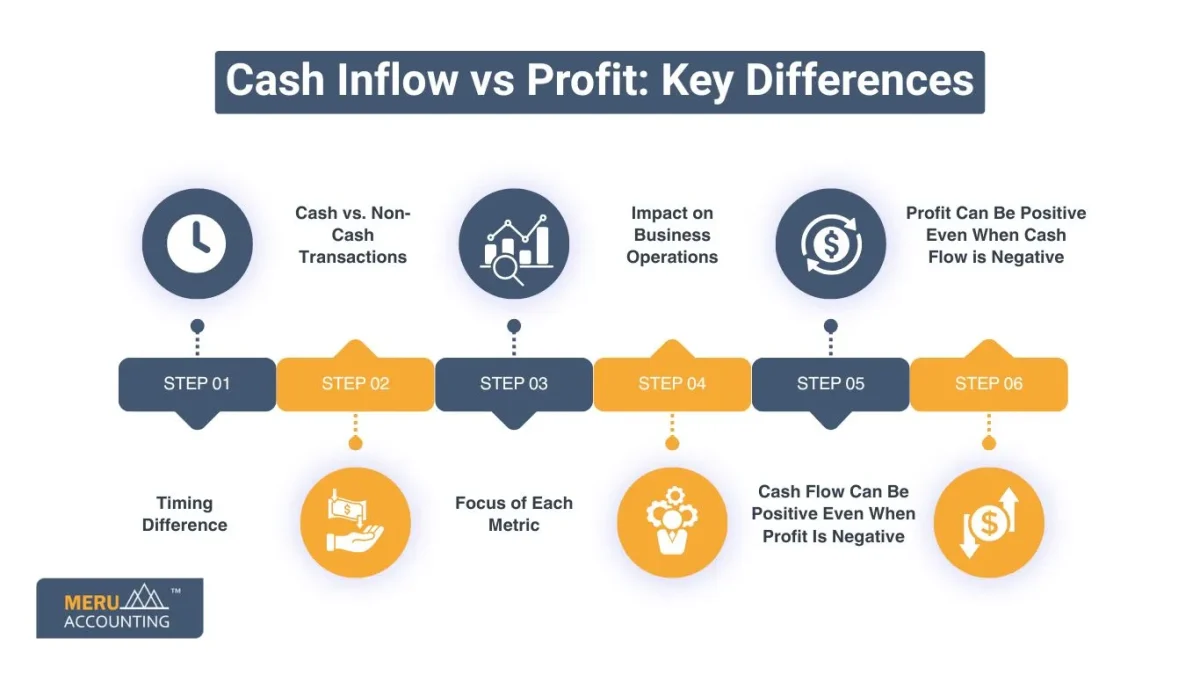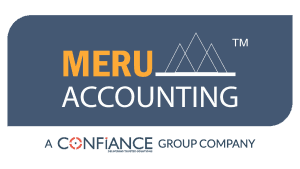Cash Inflow vs Profit Differences
Managing business finances requires understanding cash inflow and profit. These two concepts are vital to your company’s health, but they are often mixed up. In this post, we’ll explain the Cash Inflow vs Profit Differences and help you understand how each affects your decisions. Profit and cash flow are two diverse parameters relating to finance; however, when one is running a company, one has to keep track of these parameters. Cash flow is the money that would be flowing into and out of the company for tasks relating to investing, financing, and operations. We consider it money that we require to meet the present and the near-term commitments.
A company’s profit is the difference between the sales or gross income of a company and its expenditure. In principle, a company could not survive for a long period if it were not profitable. However, with cash flow, at times, a product’s success could increase the costs. In a short period, it might not be clear that this is an issue.
A business could have a cash flow that is positive, even when not having a profit, in case the cash is received from sources, apart from income, for example, when a business owner takes a loan or invests their own money. Such kinds of transactions are not income. They are, on the other hand, equity or liability transactions that we show on the balance sheet.
A business could also have a cash flow, which is negative even when it has a huge profit. This can happen in case the owners of the company take cash from the business. The reason may be for paying personal expenditure or giving loans to other people, or making investments.
What is Cash Inflow?
Cash inflow is the money that comes into your business. This can come from several sources, such as:
Sales: Revenue from selling goods or services.
Loans: Money borrowed from a bank or lender.
Investments: Money put in by owners or shareholders.
Asset Sales: Cash received from selling business assets like equipment or land.
Cash inflow is the real movement of money into your business from different sources.
What is Profit?
Profit is the money a business earns after subtracting its costs. This includes:
Cost of Goods Sold (COGS): The costs tied to making products or offering services.
Operating Expenses: Regular costs like rent, salaries, and utilities.
Taxes and Interest: Payments made to the government or lenders.
Profit shows if your business is making money after all expenses.
Cash Inflow vs Profit: Key Differences
While cash inflow and profit both matter, they have key differences. Understanding these can help you manage your business finances better.
1. Timing Difference
The main difference is when cash comes in.
Cash Inflow: Money is received soon after a sale or action.
Profit: Profit is recorded when the sale happens, but cash might not be received until later.
For example, you sell a product today. You make a sale, but the payment is due in 30 days. The profit is recorded today, but the cash inflow will happen later.
2. Cash vs. Non-Cash Transactions
Not all actions affect cash flow.
Cash Inflow: Records actual money movements.
Profit: Includes both cash transactions and non-cash items like sales on credit or depreciation.
If you sell goods on credit, your profit goes up, but cash doesn’t come in right away.
3. Focus of Each Metric
Cash Inflow: Focuses on liquidity — how much cash is available to pay bills and meet short-term needs.
Profit: Focuses on long-term financial health after all costs are considered.
Both matter, but they provide different views of your business’s financial health.

4. Impact on Business Operations
Cash Inflow: Understanding the Cash Inflow vs Profit Differences is crucial for making sure both your short-term liquidity and long-term health are balanced.
Profit: Profit shows that your business is efficient, but it doesn’t mean you have enough cash to cover bills.
A profitable business can still run into trouble if it doesn’t manage cash inflow properly.
5. Cash Flow Can Be Positive Even When Profit Is Negative
It’s possible to have positive cash inflow and still lose money. This might happen if:
You take out a loan or get an investment.
You sell assets for cash, even if the business itself is losing money.
This shows why you need to track both cash inflow and profit.
6. Profit Can Be Positive Even When Cash Flow is Negative
Similarly, a business can have a profit but still face cash flow problems. This happens when:
You sell on credit and don’t get paid right away.
You make big purchases or investments that drain your cash.
Even with a profit, you could run out of cash if your inflow isn’t strong enough.
Why Cash Inflow is Important
Liquidity: Understanding Cash Inflow vs Profit Differences is important for keeping your business liquid while also aiming for profitability.
Short-Term Decisions: Cash is needed to meet daily expenses. Without it, even profitable businesses can fail.
Debt Management: Positive cash flow helps pay off loans on time.
Why Profit is Important
Financial Health: By recognizing the Cash Inflow vs Profit Differences, you can make informed decisions about your business’s financial health.
Planning: Profit is key to planning for growth and investments.
Efficiency: Profitability shows how well your business is managing costs.
How to Monitor Cash Inflow and Profit
To stay on track, you need to monitor both cash inflow and profit:
Cash Flow Statement: This tracks cash entering and leaving your business, helping you manage liquidity.
Income Statement: This shows your revenue, costs, and profit over time, helping you assess overall profitability.
Balance Your Books: Regularly check both financial statements to make sure you have enough cash and are making a profit.
Additional Tips for Managing Cash Inflow and Profit
Understand Payment Terms
Many businesses sell on credit. This creates a gap between when you make a sale and when you get paid. If your customers pay on credit, manage that gap by offering discounts for early payment or by keeping track of overdue accounts.
Control Expenses
Even if you make a good amount of cash, expenses can get out of hand. Check your costs often and look for ways to cut back. This helps keep your profit up and your cash flow steady.
Set Cash Reserves
It’s smart to save some cash for slow months. Having a reserve can help your business cover costs when cash flow dips. This way, you won’t have to rely on loans or credit.
Forecast Cash Flow
Predicting cash flow helps you plan when cash will come in and go out. This lets you make smart choices about spending, projects, and managing cash.
Invest Wisely
As your business grows, you might want to invest. But be careful not to spend too much too fast. Make sure investments fit with your cash flow, or look into funding options that won’t harm your liquidity.
Monitor the Cash Conversion Cycle
The cash conversion cycle (CCC) tracks how long it takes to turn investments into cash. A shorter cycle means better cash flow management. Keep this cycle quick to maintain a healthy cash inflow.
For cash flow to take place in a relentless manner without the need to fund the business with a working capital loan and thereby ensure business profit, certain points need to be kept in mind by a business entrepreneur as follows:
a) ‘Prompt payment’ or ‘early payment’ discounts help in encouraging credit customers to make timely or beforehand payments for the business products or services received. This ensures that customers don’t delay payments to businesses and helps inadequate cash flow.
b) When a client gives an order for the service or product, a request for making a deposit can be made as a security and a source of funds for making the client’s order. This will suffice for making any extra expenses that the business may incur.
c) Timely receivables for the business can be assured only when the invoice is raised on an immediate basis. Along with raising timely invoices, expectations from the outset need to be clearly specified by the business, which facilitates ‘amount receivable’ for facilitating good cash flow.
d) One will be hindering an adequate cash flow by overlooking the overdue accounts. Hence, the automation of invoice remainders is essential to ensure that no overdue payment goes unnoticed.
Knowing the difference between cash inflow and profit is key to running a good business. Cash inflow helps cover daily costs, while profit shows your long-term health. Both are important and give different views of your business. By tracking both, you can stay on top of your finances and make smarter choices for growth. Meru Accounting helps businesses track cash flow and profit. With our expert services, we guide companies to manage funds, cut costs, and make smart choices for lasting success.
Frequently Asked Questions (FAQs)
What is the difference between cash inflow and profit?
Cash inflow is the actual money received by the business. Profit is what is left after all expenses are paid.
Can a business have positive cash flow but negative profit?
Yes, this can happen if a business gets cash from loans or asset sales, even if it isn’t making a profit from its operations.
Why is cash inflow important?
Cash inflow helps a business pay bills, workers, and keep things running day to day.
Why is profit important for a business?
Profit shows that the business is making more than it spends, which is key to its health and success.
How do cash inflows and profits affect a business?
Cash inflow shows if a business can meet its needs, while profit shows if it is running well overall.
Can a business have negative cash flow and still make a profit?
Yes, if it makes sales on credit or invests in things that use up cash.
How can businesses manage cash flow and profit?
Businesses should track both using income and cash flow statements regularly.








